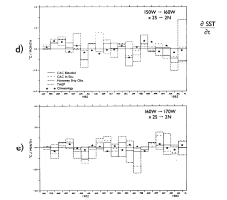

U.S. Dept. of Commerce / NOAA/ OAR / PMEL / Publications
Figure 1. Monthly average rates of change of SST for the five analysis regions, according to the NMC "in situ," NMC "blend," FNOC spot obs, and NASA THEP SST datasets (see text for more information on these SST fields, and for discussion). Note that the different fields generally differ on the sign of the month-to-month change, except when the rate of change exceeds roughly 1 degree C per month.
Figure 2. Monthly average zonal wind stress fields, averaged between 2°N and 2°S, for the different wind stress analyses used in the model hindcast experiments: ECMWF, FNOC, FSU, NMC and SADLER. See text for notation and discussion. The Hellerman and Rosenstein (1983) climatological stress is presented for comparison.
Figure 3. As for Figure 2, except meridional wind stress fields.
Figure 4. Rates of change of SST over the analysis regions, according to the five hindcast experiments, based on snapshots three days apart. See text for discussion.
Figure 5. Some SST equation terms for the 155°W region, together with the zonal wind stress over this region for the SADLER (a) and FNOC (b) hindcasts. See text for discussion.
Figure 6. As for Figure 5, except the 135°W region and the SADLER (a) and ECMWF (b) hindcasts.
Figure 7. As for Figure 6, except the 115°W region and the SADLER (a) and NMC (b) hindcasts.
Table 1. Summary of periods of consensus agreement on surface warming (+) or cooling (-). SST products are summarized in "Data," modem hindcasts results are summarized in "Model." A period marked with a bar and (+) indicates that the average over the period is for warming, but the month-to-month consensus was not found.
Go back to References or return to Abstract